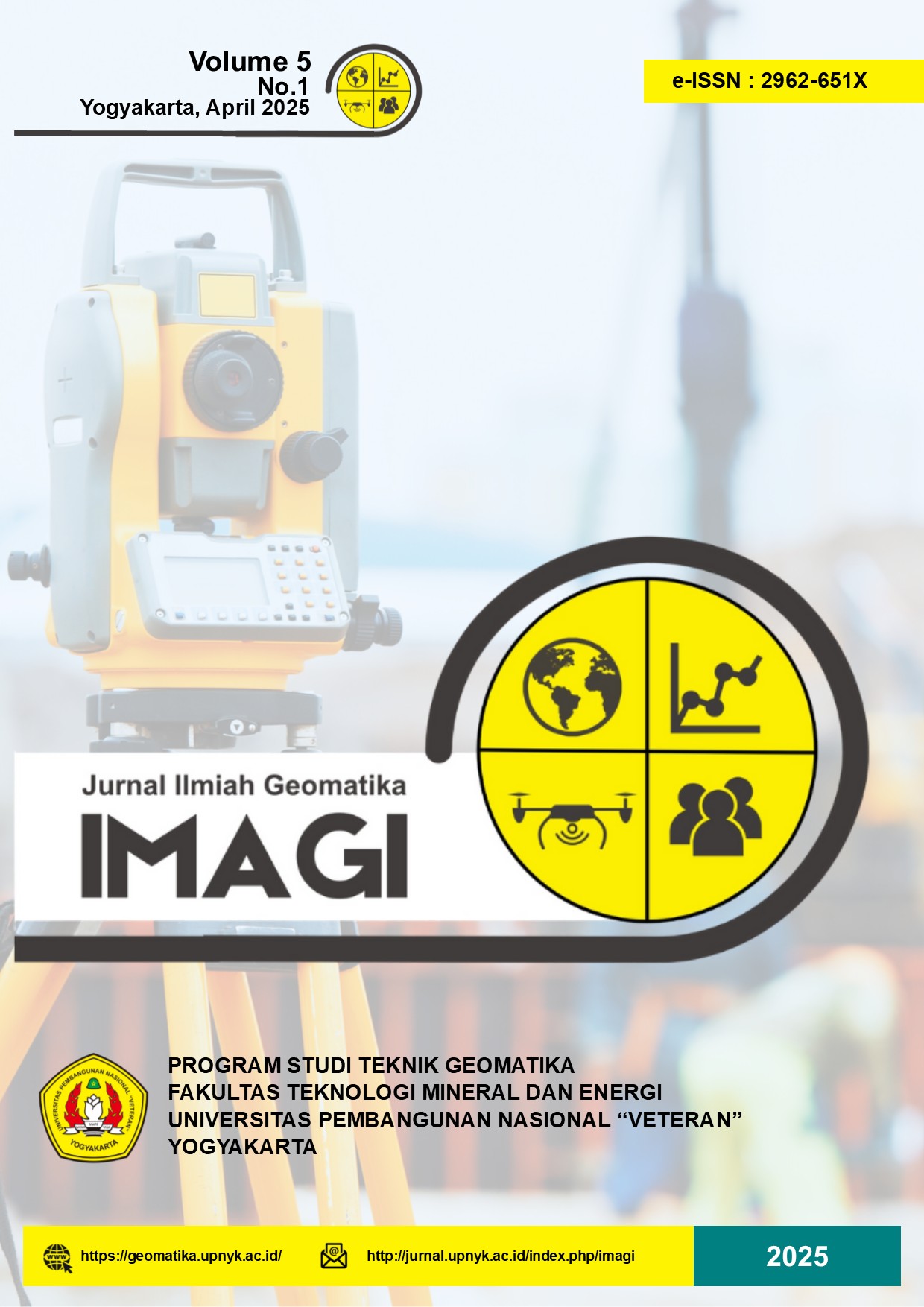Improving Surface Strip Adjustment Accuracy Using the Point-to-Plane Iterative Closest Point (ICP)
DOI:
https://doi.org/10.31315/imagi.v5i1.15027Kata Kunci:
point-to-plane, iterative closest point (ICP), strip adjustment, Pembelajaran mesinAbstrak
This study aims to evaluate the effectiveness of the point-to-plane method for LiDAR point cloud data registration, especially for strip adjustment applications. Using two different LiDAR scenes with varying land cover, a comparative analysis was conducted between the point-to-plane method and the conventional point-to-point method. The performance of the point-to-plane method was assessed based on Root Mean Square Error (RMSE), transformation matrix accuracy, fitness, correspondence, and visual observation. The results show that the point-to-plane method consistently outperforms the point-to-point approach, by producing significantly lower RMSE values, more accurate transformation matrices, and higher fitness scores across all land cover types. This study validates that point-to-plane ICP is capable of providing more robust and accurate results for topographic data registration, and offers improvements to high-precision geospatial applications.
Referensi
Baek, J. (2020). Two-dimensional lidar sensor-based three-dimensional point cloud modeling method for identification of anomalies inside tube structures for future hypersonic transportation. Sensors, 20(24), 7235.
Besl, P. J., & McKay, N. D. (1992). Method for registration of 3-D shapes. In Sensor fusion IV: control paradigms and data structures (Vol. 1611, pp. 586–606). Spie.
Cao, Q., Liao, Y., Fu, Z., Peng, H., Ding, Z., Huang, Z., … Cai, S. (2023). An iterative closest point method for lidar odometry with fused semantic features. Applied Sciences, 13(23), 12741.
Chen, H. P., Chang, K. T., & Liu, J. K. (2012). Stripe Adjustment of Airborne Lidar Data Using Ground points. In Proceedings of the Asian Conference on Remote Sensing, Pattaya, Thailand (pp. 26–30).
Chen, S., Nan, L., Xia, R., Zhao, J., & Wonka, P. (2019). PLADE: A plane-based descriptor for point cloud registration with small overlap. IEEE Transactions on Geoscience and Remote Sensing, 58(4), 2530–2540.
Chen, Z., Li, J., & Yang, B. (2021). A strip adjustment method of UAV-borne lidar point cloud based on DEM features for mountainous area. Sensors, 21(8), 2782.
Dhruwa, L., & Garg, P. K. (2023). Positional Accuracy assessment of features using LiDAR point cloud. The International Archives of the Photogrammetry, Remote Sensing and Spatial Information Sciences, 48, 77–80.
Favre, K., Pressigout, M., Marchand, E., & Morin, L. (2021). Plane-based accurate registration of real-world point clouds. In 2021 IEEE International Conference on Systems, Man, and Cybernetics (SMC) (pp. 2018–2023). IEEE.
Gökgöz, T., & M. Baker, M. K. (2015). Large scale landform mapping using Lidar DEM. ISPRS International Journal of Geo-Information, 4(3), 1336–1345.
Hexsel, B., Vhavle, H., & Chen, Y. (2022). DICP: Doppler iterative closest point algorithm. ArXiv Preprint ArXiv:2201.11944.
Kuçak, R. A., Erol, S., & Erol, B. (2022). The strip adjustment of mobile LiDAR point clouds using iterative closest point (ICP) algorithm. Arabian Journal of Geosciences, 15(11), 1017.
Liang, L., & Pei, H. (2023). Affine iterative closest point algorithm based on color information and correntropy for precise point set registration. Sensors, 23(14), 6475.
Lin, S., Wang, X., & Nan, C. (2024). Slope unit-based genetic landform mapping on Tibetan plateau-a terrain unit-based framework for large spatial scale landform classification. Catena, 236, 107757.
Lv, C., Lin, W., & Zhao, B. (2023). KSS-ICP: point cloud registration based on Kendall shape space. IEEE Transactions on Image Processing, 32, 1681–1693.
Lv, W., Zhang, H., Chen, W., Li, X., & Sang, S. (2024). A Point Cloud Registration Algorithm Based on Weighting Strategy for 3D Indoor Spaces. Applied Sciences, 14(12), 5240.
Rusinkiewicz, S., & Levoy, M. (2001). Efficient variants of the ICP algorithm. In Proceedings third international conference on 3-D digital imaging and modeling (pp. 145–152). IEEE.
Saleh, A. R., & Momeni, H. R. (2024). An improved iterative closest point algorithm based on the particle filter and K-means clustering for fine model matching. The Visual Computer, 40(11), 7589–7607.
Silva-Fragoso, A., Norini, G., Nappi, R., Groppelli, G., & Michetti, A. M. (2024). Improving the Accuracy of Digital Terrain Models Using Drone-Based LiDAR for the Morpho-Structural Analysis of Active Calderas: The Case of Ischia Island, Italy. Remote Sensing, 16(11), 1899.
Wu, Y., Shen, L., & Li, P. (2022). Semi-supervised deep closest point method for point cloud registration. In Journal of Physics: Conference Series (Vol. 2203, p. 12014). IOP Publishing.
Xu, N., Qin, R., & Song, S. (2023). Point cloud registration for LiDAR and photogrammetric data: A critical synthesis and performance analysis on classic and deep learning algorithms. ISPRS Open Journal of Photogrammetry and Remote Sensing, 8, 100032.
Yoshida, K., & Koarai, M. (2024). A simple method to automatically remove artificial terrain from airborne LiDAR DTMs in plain areas. Geomorphology, 465, 109388.
Yue, X., Liu, Z., Zhu, J., Gao, X., Yang, B., & Tian, Y. (2022). Coarse-fine point cloud registration based on local point-pair features and the iterative closest point algorithm. Applied Intelligence, 52(11), 12569–12583.
Zhang, J., Yao, Y., & Deng, B. (2021). Fast and robust iterative closest point. IEEE Transactions on Pattern Analysis and Machine Intelligence, 44(7), 3450–3466.
Unduhan
Diterbitkan
Cara Mengutip
Terbitan
Bagian
Lisensi
Hak Cipta (c) 2025 Monica Maharani, Riyas Syamsul Arif

Artikel ini berlisensi Creative Commons Attribution 4.0 International License.








